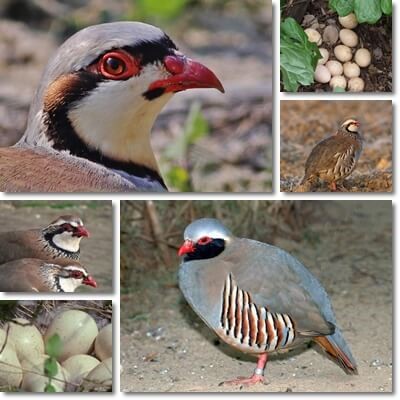Partridges are game birds in the pheasant family Phasianidae and are related to pheasants, peafowl, quails, chickens and turkey. They are heavy-bodied birds, larger than quail and smaller than pheasants. Their size is reminiscent of the smaller quail, while their plumage is similar to that of both pheasants and peafowl, depending on the species, of which there are many. Partridges produce eggs that look very similar in appearance to pheasant eggs and boast a nutritional value close to that of chicken eggs.
In some parts of the world, partridges are called ‘small wild hens’. Both the meat and eggs of partridges are edible, but because the hens lay up to 21 eggs per year, even less in some species, and the eggs are not particularly nutritious, there is little commercial value to growing partridges for egg production.

Where are partridges found?
Partridges can be found in Europe, Asia, all of Africa except for desert areas, Australia, New Zealand, Canada and the United States, in both lowland and highland areas. Their natural habitat covers tropical and subtropical forests, temperature forests, open hilly areas and stony regions as well as farmlands. The red-legged partridge (Alectoris rufa), the rock partridge (Alectoris graeca), the grey partridge, also known as the English or Hungarian partridge (Perdix perdix) and the chukar partridge (Alectoris chukar) are some of the best known species.
What do partridges look like?
Partridges are, for the most part, small, plump, round-looking birds with short, rounded wings, not suited for flying over long distances. If disturbed, they will emit a loud call and fly over short distances, although they are ground birds and prefer running. Species variety is reflected primarily in plumage.
There are partridges that look more like quails, with sandy, brown, yellow-brown, buff, gray and black feathers with various patterns ranging from spots, lines to transverse bars. There are partridges that look more like pheasants, with bright green, blue, orange-red plumage, longer tail feathers and adornments like wattles and crests. In most species, the male is bigger and more colorful than the female.
How many eggs does a partridge hen lay?
Partridges prefer to nest on the ground, in shallow nests and can often be found at the edge of cereal fields. The hens lay between 5 and 21 eggs, depending on the species. Usually, once a hen has completed her clutch, she will incubate the eggs and raise the chicks, without laying any more eggs until the following year.

What do partridge eggs look like?
A lot like pheasant eggs actually, or like guinea fowl eggs: slightly triangular in shape, meaning they are rounder at one end and pointed at the other. Eggshell color ranges from a pale off white or light cream to a pale gray yellow or pale cream brown to light brown (‘cafe au lait’, meaning coffee with milk) and even tan. The eggshell may be speckled with yellow-brown, brown or dark grey or more thickly blotched and, in some species, slightly glossy. Partridge eggs are smaller than small chicken eggs (estimated weight for small chicken eggs: 38 g), and smaller even than pheasant eggs which range in size from 27.8 to 33.7 grams.
How much do partridge eggs weigh?
On average, one partridge egg weighs 21-22 g. This is the equivalent of a little more than 2 quail eggs (1 quail egg weighs 9-10 g). Reports show the smallest partridge eggs to weigh as little as 15.9-16 g and the largest ones up to 25-26.5 g. The younger the hen, the smaller (lighter) the egg; the older the hen, the larger (heavier) the egg. Diet also plays an important part in egg weight, so the better fed the hen, the larger the egg.
What do partridge eggs taste like?
Very similar to chicken eggs, especially if the birds are raised in captivity and fed a controlled diet. Eggs from birds in the wild may taste a little gamier, but not everyone perceives them as such.
Partridge eggs nutrition information
Because the hens are not even half as prolific egg layers as chicken or quail, and thus cannot be capitalized on by the food industry to contribute to human nutrition to a larger extent, there has been little interest in the nutritional value of partridge eggs and as a result very little nutritional information is available. Most partridge eggs nutrition facts are actually generalized data extrapolated from knowledge of the nutritional value of chicken and other eggs varieties.
Partridge eggs nutrition facts
Good source of protein
Like all eggs, partridge too contain quality protein with all essential amino acids. Protein helps build and repair muscle and contributes to nervous system activity by helping with the synthesis of essential neurotransmitters for the brain. Eating eggs like partridge provides satiation and nourishes the brain.
Fats and cholesterol profile in partridge eggs
Partridge egg yolks contain both saturated and unsaturated fatty acids and cholesterol. Fats are food for the brain and help nourish it and support cognitive functions. Cholesterol in particular is good for us in limited amounts as studies show it helps make up the protective myelin sheath surrounding the tail of our nerve cells. Partridge eggs contain limited amounts of healthy Omega-3 fatty acids with anti-inflammatory benefits for cardiovascular health.
Source of B vitamins
Like all eggs, partridge too contain B vitamins, especially vitamins B9 and B12 required for normal brain and nervous system development of babies in the womb and red blood cells production. Vitamin B12 in particular is good for the nervous system because it helps make up the protective myelin sheath surrounding the tail of our nerve cells. Other B vitamins present in varying amounts in the eggs include B1, B2, B3, B6 and choline.
Other vitamins and minerals in partridge eggs
Like other egg varieties, partridge too are expected to contain zinc, phosphorus, magnesium, potassium, iron and small amounts of calcium. Vitamin E may be present in small amounts. Partridge and other eggs do not contain vitamin C.
Carbs content, fiber content, calories in partridge eggs
Partridge eggs have a low carbohydrate content, no fiber and a moderate energetic value. Partridge eggs are high in fat and protein and low in carbohydrates. Because they are an animal product, they do not contain fiber. Lastly, given their macronutrient profile (higher in fat and protein, low in carbs), they have a moderate calorie content.
What are the benefits of partridge eggs?
- Good for muscles thanks to a good protein content and a good B vitamins content.
- Help reduce brain fog and benefit concentration and improve mood (thanks to the amino acids in protein and fatty acids in fat which nourish the brain).
- As a source of protein, partridge eggs provide satiation and help with weight management and possibly also weight loss.
- Contain cholesterol and vitamin B12 which have a protective effect on nerve cells.
- Iron and vitamins B9 and B12 in partridge eggs make them good for anemia.
- Eating partridge and other eggs is good for hair and skin thanks to protein, fats, B vitamins, and various dietary minerals.
- Soft boiled partridge eggs are easy on the stomach and may help with the management of active gastritis, but not by themselves. Diet as a whole is important for gastritis treatment.
- Provide good nutrition for pregnant women (vitamins B9, B12, iron, fats and minerals) and contribute to the prevention of neural tube defects in newborns (all eggs do this).
- Energizing effect – all eggs are nutritious as they are a source of B vitamins, minerals, protein and fat.
Frequently asked questions
What do partridges eat?
Partridges eat seeds and insects. The young in particular need to eat insects for protein for normal growth and development.
Can you eat partridge eggs?
Yes, you can eat partridge eggs from all species of partridge. However, note that certain species are protected due to declining numbers and you may not eat the bird or its eggs, unless sourced from licensed farms.
How many eggs does a partridge hen lay?
Some hens lay as little as 5 days, others as many as 21. It really depends on the species, food resources available and other factors. The average partridge hen lays about 15-16 eggs. Egg season is from mid-March to mid-April, sometimes extending to May (depending on weather, region etc.). Incubation takes anywhere from 24-26 days and the chicks hatch at the end of May, beginning of June.
Where can you find partridge eggs for sale?
Not at your local supermarket. Partridges are wild birds and lay very few eggs, usually less than 20 a year. For this reason they are not attractive to farmers and those that do raise them, do it to release as many birds as possible into the wild. You may find partridge eggs for sale at hobbyist farmers or online. There are also aviculturists who raise various species, but they work towards sustaining populations in view of species conservation.
